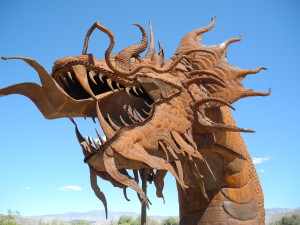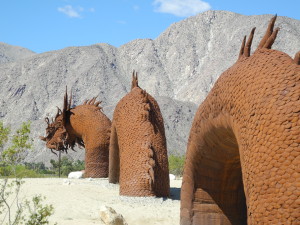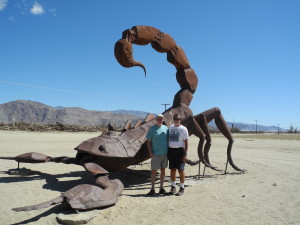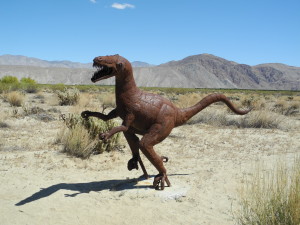
This dragon’s head is one of sculptor Ricardo Breceda’s most riveting works. Photo by Catharine Norton.
During our recent visit to Anza-Borrego Desert State Park in southern California, my wife, Catharine, and I and four of our closest friends went searching for spring wildflowers, cactus blooms, and palm oases, and hoped to spot some of the park’s iconic bighorn sheep on our hikes.
We were successful on all fronts except for catching a glimpse of the elusive bighorn sheep, which probably spotted us first and decided to retreat into the park’s rugged canyons and mountains.
But we did see something that I wasn’t expecting at all: one of the greatest displays of public art I’ve ever encountered in the U.S., occupying the desert flat lands outside the town of Borrego Springs, which lie adjacent to the most traveled areas of the park.
As our friends from California took us on a driving tour of the area, Catharine and I were startled to see a “magical menagerie,” as the local visitors’ bureau aptly describes it, of animals roaming the deserts off the roadsides.
At first glance the animals appeared to be real: wild horses, camels, llamas, sheep, tortoises — animals that would actually be at home in these hot, dry lands. Adding to the illusion, many were permanently posed in action modes, such as wild horses battling for dominance or a scorpion rearing its head.
But as we turned onto the sandy paths that cut through the barren meadows and got closer looks, we could see they were actually rust-colored metal sculptures — some smallish, some enormous — with many representing mythical or long-extinct species: dinosaurs, saber-toothed tigers, giant sloths, mammoths. Most dramatic of all was a fierce-looking multi-part dragon that snaked over both sides of the road.
The close-up detail was stunning, right down to the scales on the dinosaurs and the metal eyelashes that graced many of the creatures.
A few humans are also thrown into the mix, including one sculpture of Spanish explorer Juan Bautista de Anza, for whom the park is named (along with the “borrego” — which means “bighorn sheep” in Spanish).
The prolific artist, we discovered, is named Ricardo Breceda, who has been producing the sculptures for about eight years and now has completed several dozen, all strategically placed in Galleta Meadows, a huge swath of land owned by a private benefactor.
You can pick up maps around town that show the general locations of the sculptures, or you can just drive out Borrego Springs Road (either north or south) and try to spot them on your own. A four-wheel drive vehicle helps when trying to negotiate the sandy paths (“roads” is stretching it) to get close-up views of some of the sculptures.
For more information, the Borrego Springs Chamber of Commerce and Visitors’ Bureau (760-767-5555) is located at 760 Palm Canyon Drive in Borrego Springs, California.













Leave a Reply